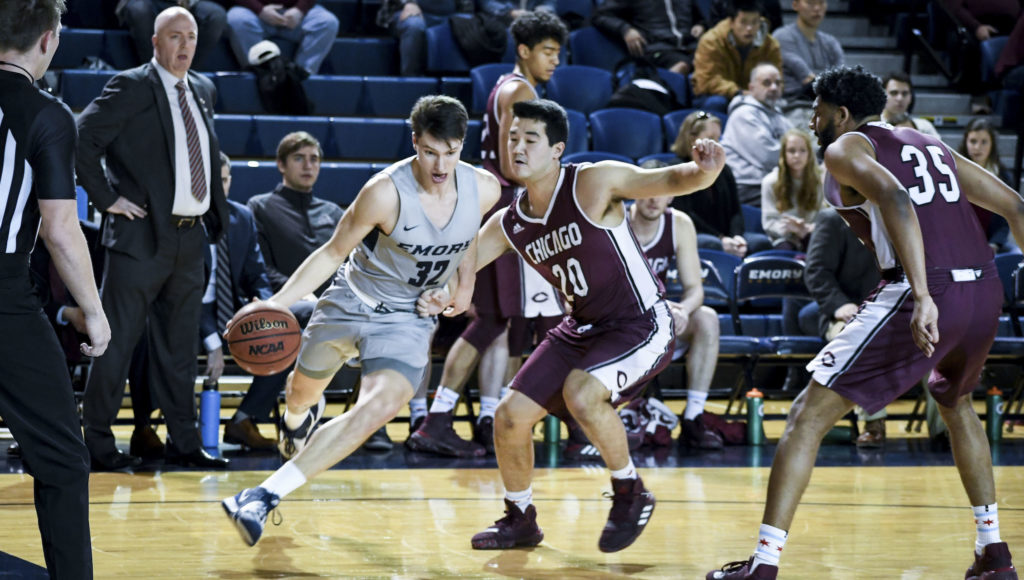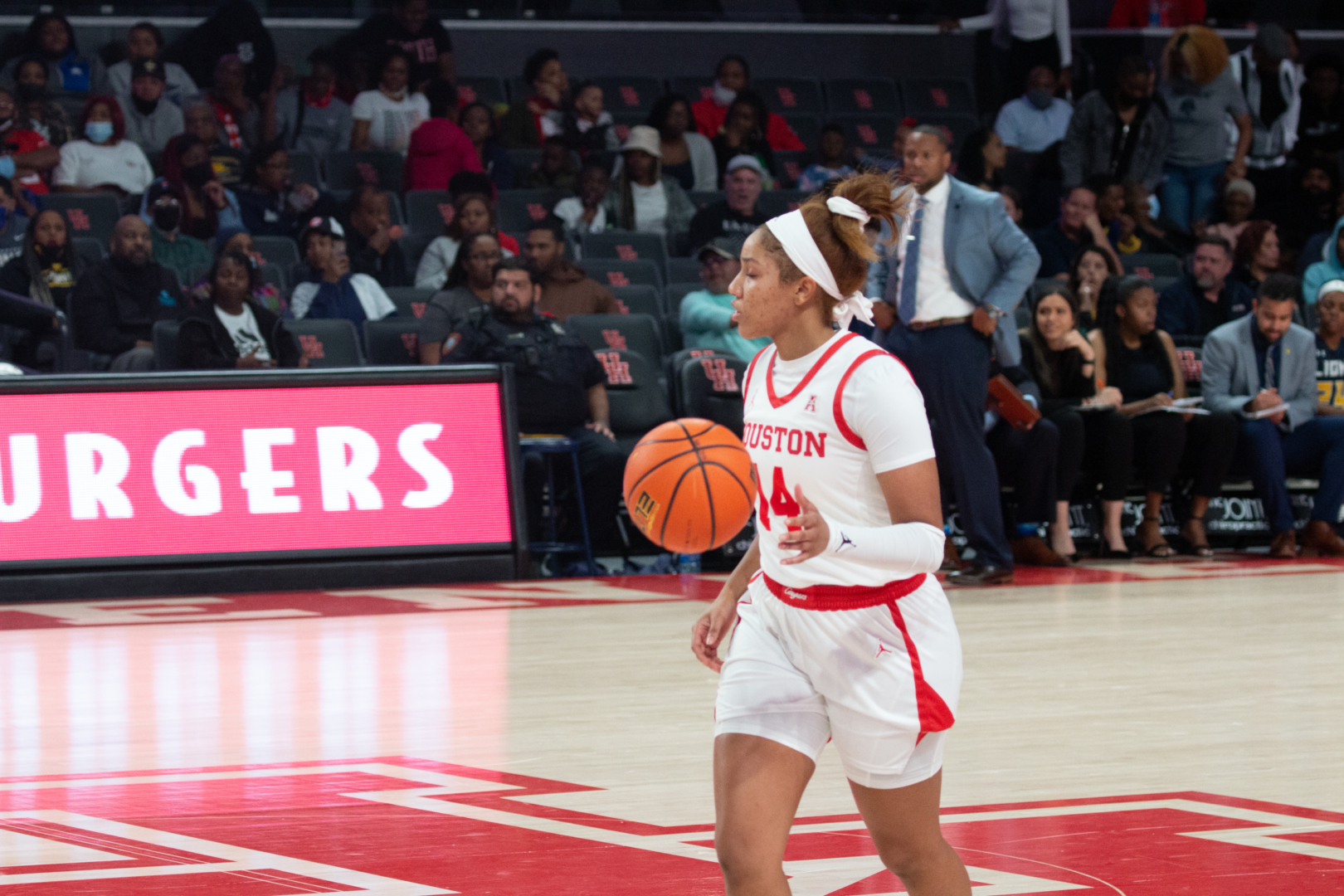Posted on 07 January 2022.

Then-junior guard Matt Schner dribbles past a University of Chicago defender on Feb. 7. Now a senior, Schner looks to lead the men’s basketball team to the NCAA Tournament. (Jackson Schneider/A&E Editor)
The Emory University men’s basketball team is adapting to the new reality in 2021 after no season in 2020. For much of the pandemic, it was hard for the players to find a basketball hoop or a fitness center to keep their games sharp. Nonetheless, seven games into the season, the team has acquired four wins, a promising start in non-conference play.
Head coach Jason Zimmerman is in his 14th year as the Eagles head coach, but his 13th season during the pandemic brought intense challenges to the program.
“This last year has been brutal for everybody and our basketball program,” Zimmerman said. “It is challenging, but we’re back at it now. It still stings, it’s like a loss and it never goes away. But you learn and grow from it.”
Due to the lost season, the team is now composed of many different ages and skill sets. For the first years and sophomores, this season will be their first competition season, presenting obstacles for the program.
“We have a good mix of veteran guys and new guys,” Zimmerman said. “Really, we have two freshmen classes.”
For first-year forward Cale Martens, the dream to play collegiate ball was met with a difficult recruitment process. The pandemic prevented Martens from showing off his skills in-person to coaches, which put playing college basketball into question for him.
“It was really difficult to have coaches come watch me in person,” Martens said. “I had to promote myself over social media with game film. I did not end up meeting Coach [Zimmerman] in person until this summer.”
Despite the hurdles, Zimmerman likes what he sees from his squad on a daily basis, especially considering the circumstances of the last year.
“We’re competing and getting better,” Zimmerman said. “This year’s team is developing a story of its own, a character of its own.”
This development has been in part due to a high-level of intra-squad competition in the fall leading up to the season. The players constantly played pick-up games and were in the weight room, competing and bonding as a team. Fifth year guard Matthew Schner, as a team veteran, emphasized the importance of this competition to his teammates.
“For us, it was all about competing as much as possible because we hadn’t competed in so long,” Schner said. “It was important for us to get that back in the fall. When we’re playing pick up games, it’s got to be competitive and taking every day and improving with it. That is something that we talk about every day and try to instill.”
Returning to some sense of normalcy has been satisfying, especially for the older players who knew what they were missing out on in the lost season. Fifth year guard Nick Stuck is excited to be back in the gym and competing for the first time in a long time.
“The training was back to somewhat normal,” Stuck said. “It’s just so good to be back. I can’t stress that enough.”
The depth of the team has positively impacted the preseason and early games. First years such as Martens have been able to learn from the more experienced leaders like Schner and Stuck.
“The captains and the older guys did a really good job helping explain little details about the offense and defense,” Martens said. “That helped us prepare for once the season got rolling. I love all the older guys. They have been really welcoming and helpful. Not just in basketball but academically and socially.”
Schner has been one of the stars of the team since his first year. Over his career at Emory, Schner has averaged 13.8 and 15.5 points per game, respectively. This season, he is close to averaging a double-double with 20.7 ppg, 9.6 rebounds per game and 4.1 assists per game. Before the season, Schner was awarded a Preseason All-America Honorable Mention. Earlier in December, Schner was also named to the D3Hoops.com Men’s Basketball National Team of the Week.
Stuck is also contributing heavily, leading the team in assists with 5.4 per game and ranking second in scoring and steals with 12.6 ppg and 0.9 steals per game. The six-foot-two guard is definitely a playmaker for the Eagles as his game complements Schner’s. Together, they are and continue to be a great one-two punch for Emory on both sides of the court.
On top of their on court talents, Schner, Stuck and other older players have taken on heavy leadership roles this season. As a role model for the team, Schner has felt the pressure to set the standard for the younger players.
“It’s a big leadership role for me and for the other guys that have been around,” Schner said. “That’s been a challenge, and it’s been something that’s been good for us throughout the fall and continuing into the season. You have to lead by example: you have to be the first guy in the gym and the last one to leave.”
The skills and leadership have been solidified through Zimmerman. He has helped the team adjust through the pandemic and the new season despite all the obstacles.
“This is year five with Coach Z,” Schner said. “We have a great trust for each other. We both understand that we are incredibly committed to the program and we respect that about each other.”
Even with solid team chemistry and a competitive drive, the Eagles know they have a tough road ahead for competition play. The Eagles stand at 7-3, and while they hold a winning record, the team knows they are not up to their full potential yet. After a loss against Randolph-Macon College (Va.), the number one team in the country, Zimmerman got a better glimpse at how the team fared against the highest-level of competition.
“We were prepared as we could be for our guys,” Zimmerman said. “It was a great game to see where we are right now for the country. It was also a great game to see where we are individually. We will use that as a springboard for the rest of the year.”
After time off for the holidays, the Eagles will open conference play in the University Athletic Association (UAA). However, Schner is aware of how different conference play may be from the past.
“Normally we have a better idea on who we are going to play against,” Schner said. “It’s a two-year gap. I don’t recognize the names that I usually do year-to-year. This is going to be a big adjustment.”
Ultimately, the Eagles look to make a run in the NCAA tournament. Emory has made eight consecutive NCAA Tournaments; however, the Eagles this year not only want to extend their streak to nine, but also want to go farther than ever before.
“I want to take this program to places we have not been before, and for us that is the Final Four,” Schner said. “We are a long way off from doing that. It’s a big challenge but that is something that is always in the back of my head so we can leave the jersey in a better place when we leave.”
There is a lot to be impressed with from the Emory men’s basketball team. Led by an outstanding coach and experienced veterans, the team is looking for success this year, despite the challenges the pandemic brought. Their outlook on the rest of the season is bright, and all signs point to a great run in the UAA and NCAA tournaments.
The men’s basketball team opens up UAA competition on Jan. 8 at the University of Rochester (N.Y.) and hosts Washington University in St. Louis (Mo.) for their home opener on Jan. 14.
The post ‘Good to be back’: Emory men’s basketball shooting high this season appeared first on The Emory Wheel.










